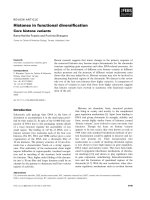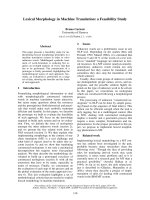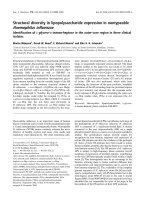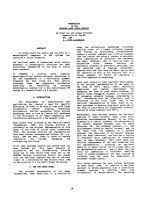Micellar morphology in bulk styrene core
Bạn đang xem bản rút gọn của tài liệu. Xem và tải ngay bản đầy đủ của tài liệu tại đây (483.34 KB, 4 trang )
Macromolecules 1994,27, 5086-5089
5086
Micellar Morphology in Bulk Styrene-Core Ionic Diblock
Copolymers
Diep Nguyen,+Sunil K. Varshney; Claudine E. Williams? and
Adi Eisenberg'J
Department of Chemistry, McGill University, Montreal, Quebec, Canada H3A 2K6,and
Laboratoire pour 1'Utilisation du Rayonnement Electromagn6tique (LURE),
CNRS-CEA-MEN, UniversitB Paris-Sud, 91405 Orsay Cedex, France
Received January 6, 1994; Revised Manuscript Received May 6, 1994'
ABSTRACT: Diblock ionomers consisting of a short polystyrene block and a long ionic segment of poly(4-vinylpyridinium methyl iodide) or poly(cesium methacrylate) have been investigated by small-angle X-ray
scattering in the solid state. The size of the spherical microdomains formed by the polystyrene blocks in the
continuous ionic matrix has been measured and compared to that of the mirror system consisting of an ionic
core in a nonionic matrix, previously investigated. Similar chain stretching of the core-forming block is
observed for both systems, and it is concluded that the chain extension in the microdomains is due to the
high surface energy between the ionic and the nonionic phases rather than to specific ionic interactions. In
addition, the core radii of the two mirror systems were fitted to the predictions of the star model for block
copolymers, R a ~ N B where
~ / ~ NB
, is the length of the core-forming block.
Introduction
Microphase separation is a common feature of most
block copolymers because of the incompatibility between
the different segments. In block ionomers, i.e., block
copolymers in which one of the moieties contains charged
groups, the dipolar attraction between the ionic blocks in
an apolar medium further enhances phase separation.
Furthermore, since the ion content is kept low in ionomers,
usually at less than 20 mol % ,the ionic blocks of AB and
ABA block ionomers are short and self-assemble into
spherical microdomains dispersed in the nonionic matrix.
The assemblies can be described as inverted micelles, by
analogy to the reverse micelles formed by low molecular
weight surfactants. Previous structural studies by smallangle X-ray scattering (SAXS)
small-angle neutron
scattering (SANS)14 and transmission electron microscopy
(TEM)5 of polystyrene-based block ionomers in the dry
state have shown that the short ionic blocks are highly
extended in their spherical microdomains14 whereas the
polystyrene blocks are not affected by the strong binding
of their chain ends and, on average, keep a Gaussian
c~nfiguration.~
It was suggested that the extension, which
minimizes the total interfacial area, is due to the high
surface energy difference between the two highly incompatible blocks rather than to the ionic character of the
micellar core.
To ascertain experimentally whether this hypothesis is
correct, one should use a mirror system to the one described
above, i.e., one consisting of spherical nonionic microdomains dispersed in an ionic matrix and, most importantly, which has the same interfacial energy. For this
purpose, diblock ionomers with a short nonionic segment
of polystyrene and a long ionic one of poly(4-vinylpyridinium iodide) or poly(cesium methacrylate) have been
investigated by SAXS. We show in this report that the
short nonionic (polystyrene) segments are also highly
extended in their microdomains.
* To whom correspondence should be addressed.
t
Department of Chemistry, McGill University.
t LURE, CNRS-CEA-MEN, UniversitB Paris-Sud.
@Abstractpublished in Advance ACS Abstracts, July 15, 1994.
Experimental Section
1. Reagents and Solvents. Styrene and cu-methylstyrene
(Aldrich) were dried over CaHz for 24 h, distilled under vacuum,
and stored under nitrogen at -20 "C. They were then treated
with fluorenyllithium for 15min and distilled under vacuumjust
prior to the polymerization. 4-Vinylpyridine (Aldrich)was dried
over CaHz for 24 h, distilled under vacuum, and stored under
nitrogen at -20 "C. It was treated with a mirror of sodium under
nitrogen (a light yellow color developed) and distilled under
vacuum just before the polymerization. tert-Butyl methacrylate
(tBuMA)(Polysciences)was alsodried over CaHzfor 24 h, vacuum
distilled, and stored under nitrogen in the dark at -20 "C. It was
treated with a 10 w t % triethylaluminum solution in hexanes at
0 "C until a persistent greenish-yellow color was observed? It
was finallydistilled under vacuum prior to polymerization. Tetrahydrofuran (THF) was purified by refluxing over a sodiumbenzophenone complex under dry nitrogen, a blue-violet color
indicating a solvent free of oxygen and moisture.
The initiator used to prepare poly(styrene-6-tert-butylmethacrylate) (PS-b-PtBuMA) and poly(styrene-b-4-vinylpyridine)
(PS-b-P4VP)diblock copolymer was the reaction product ofsecbutyllithium with a few units of CY-methylstyrene'in THF. It
was prepared in the glass reactor which was also used for the
polymerization. A deep red solution was developed at room
temperature.
2. Polymerization. The anionic block copolymerization of
styrene and tBuMA or 4VP was carried out under a nitrogen
atmosphere in a preflamed glassreactor, the monomers,solvents,
and initiator being transferred by syringe and capillary techniques. Block copolymerization was carried out in THF at -78
"C. Styrenewasadded dropwise,withvigorous stirring, by means
of a capillary. The dark red color of the initiator solution changed
quickly to a deep orange-yellow color. After a few minutes, the
color of the solution turned back to red, indicating the completion
of styrene polymerization. An aliquot of the solution was
withdrawn for analysis by size exclusion chromatography (SEC)
to determine the chain length of the polystyrene block. tBuMA
or 4VP was then added to the polymerization medium. Upon
addition of a few drops of the tBuMA or 4VP, the red color of
the living poly(styryl1ithium) anions changed instantaneouslyto
a light yellow color for tBuMA anions or a deep orange-yellow
color for 4VP anions. After 15 min the reaction was terminated
with methanol. The polymer was recovered by precipitation in
hexanes and dried in a vacuum oven at 80 "C for 48 h.
3. Polymer Characterization. Size exclusion chromatography (SEC) was performed with a Varian 5010 liquid chromatography unit equipped with four columns of lO',lOS, 500, and
100 A (Shoko Ultrastyragel) with THF as the eluent at a flow
rate of 1 mL/min at 30 "C. Standard polystyrenes were used to
t
Z 1994 American Chemical Society
Micellar Morphology in Diblock Copolymers 5087
Macromolecules, Vol. 27,No. 18, 1994
Table 1. Relevant Parameters for the Systems.
parameters calcd from SAXS
PS-b-PtBuMAb
24-b-80
24- b-165
1.20
1.30
50
50
(45)
50
56
58
69
54
56
43
45
67
54
40-b-150
1.30
PS-b-P4VPC
19-b-95
50
54
53
42
a Polystyrene blocks have M,/M,, = 1.10. Value determined by
SEC. Value determined by proton NMR. R h p values were
deduced from shape factor peaks. e Values of R were deduced from
space-filling calculations.
52
60
CG
C'
c2
I
"
0 '
calibrate the instrument, and the number-average molecular
weights of the polystyrene and block copolymers with poly(tertbutyl methacrylate) (PtBuMA)were calculated using Varian DS604 computer software. As the block copolymer of PS-b-P4VP
was not eluted in these columns in THF at 30 O C , the composition
of this block copolymer was determined by proton NMR. The
relevant parameters of these diblocks are presented in Table 1.
4. Hydrolysis. PS-b-PtBuMA block copolymers were hydrolyzed to polystyrene-b-poly(methacry1icacid) (PS-b-PMAA)
usingp-toluenesulfonicacid (PTSA)as a catalyst.* The polymer
was recovered and purified by repeated precipitations into cold
methanol. It was then vacuum dried at 50 "C for 48 h.
5. Neutralization.
The dried PS-b-PMAA block copolymers were neutralized in
benzene/methanol (5050 v/v) with a stoichiometric amount of
CsOH. The methanol was removed under vacuum and the
ionomers were recovered by freeze-drying. The samples were
further vacuum dried at 60 O C for 72 h.
6. Quaternization. Quaternization of samples of PS-b-P4VP
diblock copolymers with CHJ was performed in THF at room
temperature using a procedure similar to that described by Arai
et a1.0
The abbreviationsused to indicate the copolymer composition
are as follows: PS(19)-b-P4VP(95)means a polystyrene chain of
19 units joined to a poly(4-vinylppidine)chain of 95 units. The
quaternized form is denoted by the extension MeI. Similarly,
PS(25)-b-PMACs (165)indicates a polystyrene chain of 25 units
joined to a poly(methacry1icacid) chain of 165 units neutralized
with Cs.
7. Samples for SAXS. The neutralized PS-b-PMACs
samples were dissolved (10wt %) in a THF/methanol(7030v/v)
solvent mixture. The quaternized PS-b-P4VPMeI copolymer
was dissolved (10 w t 7%) in a DMF/water (955 v/v) solvent
mixture. Slow evaporation of the solvents over a period of 48 h
at room temperature yielded brittle films that were further
vacuum dried at 60 O C for 48 h prior to SAXS investigation.
8. SAXS Instrumentation. The small-angle X-ray scattering experiments were performed at the D22 stationlOJ1 of the
LURE-DCI synchrotron radiation source (Orsay,France). The
double-crystal,fixed-exit monochromator was tuned to provide
a beam of 9 keV, collimated to about 1mm2at the sample. The
beam path, including the sample holder, was kept under vacuum.
The scattered X-rays were detected with a Xe-COZ gas filled,
one-dimensional position-sensitive detector with a spatial resolution of 257 pm. All the samples were studied in the angular q
range from 0.006 to 0.30
( q = 47r sin @/A, where B is half the
scattering angle and X is the X-ray wavelength). The resulting
intensity (I)vs q curves were corrected for beam decay, sample
absorption, and sample thickness; a background scattering from
a polystyrene homopolymer or from the empty sample holder
was subtracted.
Results and Discussion
A sharp asymmetric peak followed by a weaker broad
halo at higher q was observed for all PS-b-PMACs samples;
for the PS-b-P4VPMeI sample, only a broad asymmetric
peak was seen. Figure 1presents the SAXS profile of the
sample PS(24)-b-PMACs(165);for comparison, the profile
31
GO
'
'
e
'
01
02
Figure 1. SAXS profile of PS(24)-b-PMACs(165). The insert
shows the mirror system of PS(166)-b-PMACs(25).
of the "mirror" system of this sample? i.e., PS(166)-bPMACs(25), is also shown as an insert. The scattering
pattern of the nonionic core system has the same general
features as that of the ionic core system. The only
difference observed here was that the peak at high q is
broader and less intense. Because of the similarities, the
SAXS data have been analyzed in the same way as was
used for the inverse micelle
Here also a spherical
morphology has been assumed for the nonionic domains,
justified by the low volume fraction of the polystyrene
phase (<13% in this case). Note that for the mirror system,
the presence of spherical ionic microdomains has been
well documented's2 and further confirmed by transmission
electron microscopy (TEMIe5Here the volume fraction
of each block is such that the continuous phase is P4VPMeI
or PMACs while the core is the nonionic polystyrene.
The first peak is attributed to an interparticle correlation
while the second one, at higher q, is the shape factor for
polydisperse spheres. The SAXS data analysis is based
on the assumption that the system is completely microphase separated and that the interphase thickness is
negligible. This assumption is reasonable in view of the
high driving force for the phase separation between the
ionic and the nonionic segments, as was also observed for
the reverse micelle systemsl4 that have the same ionic
and nonionic segments (P4VPMeI or PMACs and PS)
and therefore the same interaction parameters x. As for
the mirror system, the radius of the microdomains has
been estimated by two independent methods. First, the
position of the shape factor peak provides a direct
measurement of the radius, R, of the microdomains since
its minima occur at qR = 4.5 and 7.7 for i = 1and 2.13~14
Polydispersity in the sizes of the spheres smears out the
minima of the scattering curve until the profile appears
smooth for polydispersities larger than 1.1. Such is the
case for the PS-b-P4VPMeI samples. In principle, one
can fit the shape factor peak to the theoretical curve for
scattering from spherical objects, assuming a certain
distribution in the domain sizes. Here, only the position
of the first minimum is visible and only it was used to
derive the radius. The complete fit of the shape factor
was not meaningful because of the poor signal-to-noise
ratio. The second method is indirect and relies on spacefilling arguments. Bragg's law has been boldly applied to
the position of the first maximum to deduce a characteristic
distance, dg. Knowing the Bragg distance and the volume
fraction of the polystyrene phase, it is possible, by using
space-filling calculations, to compute a radius of the
Macromolecules, Vol. 27, No. 18, 1994
5088 Nguyen et al.
h
"d
c:
2E
a!-
,
,
,
,
1
'5
20
30
;
-
AC
C^
""
Number of units per block
(microphase domain)
Figure 2. Graph of experimental radius vs number of units per
block (microphase domain). The values of the radii of the ionic
core are from ref 2. The solid and dashed curves correspond to
a fit of the experimental points to Halperin's m0de1.l~
spherical microdomains assuming that they are arranged
on simple cubic, body centered cubic, face centered cubic,
or hexagonal close packed lattices.12 The values of R
calculated by both methods are given in Table 1. It should
be noted that the best agreement (within 1074 ) between
the sizes calculated by both methods is obtained for spheres
arranged on a simple cubic lattice. For the sample PS(40)-b-PMACs(150),where the shape factor peak is not
well defined, the agreement is poorer, with a difference of
20%. For the PS-b-P4VPMeI sample, no shape factor
peak was observed. Hence, the values derived for the
simple cubic lattice have been considered, only because
they provide the best agreement with the shape factor
values. The same conclusion concerning the lattice
symmetry was reached for the reverse system.2 However,
it should be kept in mind that the strict application of
Bragg's law for such a distorted lattice is limited. In the
absence of higher order peaks, other types of order (e.g.,
liquid and amorphous) are also a possibility.
A summary representation of the variation of the radius
of the spherical microdomains with the number of units
per block, N , in each microdomain is given in Figure 2. For
comparison, the values of the radii of the ionic cores2 for
a number of different systems are also included. It can
be seen that the radius of the nonionic core is strongly
dependent on the number of units in the blocks which
make up the phase-separated microdomains. This is in
agreement with our previous experimental conclusions for
the case of ionic core micelles and with an independent
study of Wilkes et al.3 Figure 2 also shows the random
coil end-to-end dimension for PSI5 segments, r, which was
calculated using the relation r = (C,N12)1/2, where C , =
9.5,1= 1.54 A, and N is the number of C-C bonds. The
random coil dimensions have been calculated for segment
lengths of 25 units or more. It is noted that the radius of
the microdomains is of the same order as the extended
length of the block. For instance, for N of 20 units, the
fully stretched planar zigzag length, obtained by multiplying the number of units of the core forming block by
2.5 A, is 50 A compared to the experimental radius of 50
A. This was also observed for the ionic core.lP2 High
extension of the segment has also been found theoretically
for copolymers in the "superstrong segregation" limit,l6
Le., when x is very large; however, this model predicts a
linear variation of R with N, for all N, which does not seem
to be obeyed in the full range of block lengths investigated
here.
The parallel behavior of these two systems, Le., ionic
spheres in a nonionic matrix and nonionic spheres in an
ionic matrix, shows that the high extension of the short
chains in their microdomains is not due to specific
interactions in the core but, more likely, to the high
incompatibility between the two polymers. Indeed,
because of the high surface energy between the ionic and
nonionic phases, the system would tend to maximize the
sizes of the microdomain spheres to minimize their total
surface area as well as their number. The shorter the
chains, the less energy is required to stretch them. With
increasing chain length, the energy requirement for
complete extension increases exponentially." Therefore,
with increasing chain length of the core materials, the
energy balance will be less favorable to chain extension.
In a parallel SAXS investigation of the solution properties of AB diblock ionomers with short ionic segments and
long PS blocks in toluene, which is a selectivelygood solvent
for the polystyrene blocks, it was found that the sizes of
the ionic cores of the samples in solution were the same
as those in the solid state when cast from the same solvent.18
Furthermore, the radii of the ionic microdomains, in
solutions, were found to scale with the number of units in
~,
with Halperin's
the ionic blocks, NB,a s N ~ ~in/agreement
model for block copolymer micelles in a selective solvent.19
In this starlike model, the equilibrium structure is
determined by the balance of the surface energy of the
core, the stretching penalty of the core blocks and of the
swollen corona blocks.20
Because of the similarities mentioned above between
solutions and cast samples, the data for ionic core samples
from ref 2 and these data for the PS core have been fitted
with the same scaling law. As seen in Figure 2, the
agreement is quite satisfactory. The prefactor a, which
is probably related to the molecular characteristics of the
polymers, is found to be 9.1 for both ionic systems and 7.2
for the nonionic system. The values seem reasonable in
views of the differences in the monomer volumes, 255 A3/
molecule for P4VPMeI,210 A3/moleculefor PMACs, and
160 A3/molecule for PS.
Conclusions
Nonionic core micelles in an ionic matrix have been
obtained with diblock ionomers of short polystyrene chain
lengths and long ionic block lengths. Their morphology
in the solid state, as studied by SAXS, has been compared
to that of the Ymirror"system consisting of ionic core in
a nonionic matrix. It was found that the short polystyrene
blocks in the core are highly stretched, as was the case for
the ionic chains in the ionic core systems. Thus, it is
concluded that it is the high surface energy rather than
the ionic character that drives the chain extension. It was
also found that the radii of the microdomains scale as
Ng3l5 ( N B is the length of the core-forming block) as
predicted by the star model for block copolymers.
Acknowledgment. This work was supported by the
Natural Sciences and Engineering Research Council of
Canada (NSERC). D.N. is grateful to Le Fonds pour la
Formation de Chercheurs et 1'Aide B 1aRecherche (Quebec)
for graduate scholarships. Constructive discussions with
Avi Halperin are gratefully acknowledged.
References a n d Notes
(1) Gouin, J. P.; Williams, C. E.; Eisenberg, A. Macromolecules
1989, 22, 4573.
Macromolecules, Vol. 27, No. 18, 1994
(2) Gouin,J. P.; BossB, F.; Nguyen, D.; Williams, C. E.; Eisenberg,
A. Macromolecules 1993,26,7250.
(3) Venkateshwaran, L. N.; York, G. A.; DePorter, C. D.; McGrath,
J. E.; Wilkes, G. L. Polymer 1992, 33 (111, 2277.
(4) Gouin, J. P.; Williams, C. E.; Eisenberg, A. Macromolecules
1992,25, 1368.
(5) Nguyen, D.; Zhong, X. F.; Williams, C. E.; Eisenberg, A.
Submitted for publication in Macromolecules.
(6) Allen, R. D.; Long,T. E.; McGrath, J. E. Polym. Bull. 1986,15,
127.
(7) Teyssie, Ph.; Jerome, R.; Ouhadi, T.; Fayt, R. U.S. Patent
4,461,874, July 4, 1984.
(8)Long, T. E.; Kinstel, J. F., Eds. ACS Symp. Ser. 364 1988,
Chapter 19.
(9) Schwab, F. C. Ind. Eng. Chem. Prod. Res. Dev. 1984,23,435.
(10) Dubuisson,J. M.; Dauvergne,J. M.; Depautex, C.; Vachette, P.;
Williams, C. E. Nucl. Intrum. Methods Phys. Res. 1986, A246,
636.
Micellar Morphology in Diblock Copolymers 5089
(11) Storey, R. F.; George, S.E. Polym. Mater. Sci. Eng. 1988,58,
985.
(12) The mass densities of PS, P4VPMe1, and PMACs were taken
as 1.05, 1.6, and 1.7 g/mL, respectively.
(13) Hashimoto, T.; Nagatoshi, K.; Todo, A.; Hasegawa, H.; Kawai,
H. Macromolecules 1974, 7, 364.
(14) Guinier, A,; Fournet, G . Small Angle Scattering of X-rays;
Wiley: New York, 1955.
(15) Polymer Handbook, 3rd ed.; Brandrup, J., Immergut, E. H.,
Eds.; John Wiley and Sons: New York, 1989.
(16) Nyrkova,I. A.; Khokhlov,A. R.; Doi, M. Macromolecules 1993,
26, 3601.
(17) Flory,P. J. Principles of Polymer Chemistry;CornellUniversity
Press: Ithaca, NY, 1967.
(18) Nguyen, D.; Williams, C. E.; Eisenberg, A. Submitted for
publication in Macromolecules.
(19) Halperin, A. Macromolecules 1987,20,2943.
(20) Daoud, M.; Cotton, J. P. J. Phys. 1982,43, 531.









